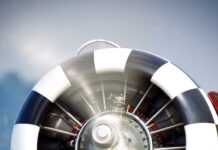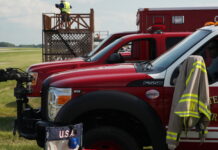Over the years, the air show industry has successfully (mostly) lobbied to have crash/fire/rescue vehicles and personnel positioned on the flight line at air shows in such a manner that they are able to respond quickly to any crash within the air show aerobatic box.
Unfortunately and sometimes with tragic results, the responsiveness of these crash/fire/rescue teams has not always been as fast or as coordinated as circumstances demanded. Many air show veterans can remember family picnics and cook-outs held under the shadow of a fire truck. In other cases, important details related to when and how CFR vehicles would respond were not coordinated prior to the show or during the pre-show safety briefing, resulting in confusion and misunderstandings in the key seconds immediately following an air show accident.
CFR is more than a box on a pre-show safety check list that needs to be checked. It is a philosophy/procedure/process that needs to be understood, de-bugged, effectively communicated and constantly re-visited.
A few specific pieces of advice that are driven by real-world example and tragedies…
- CFR/airport control tower/air boss issues are best resolved BEFORE an accident, not during the critical seconds following an accident. Nobody wants a second accident involving CFR vehicles crossing a runway that is being used by a landing aircraft, but it is critical that CFR vehicles not be left waiting for tower clearance as they respond to an accident. CFR should always have the right of way.
- CFR personnel should be briefed to be in a state of readiness that assumes in accident is imminent throughout the waiver period. From the second the first aircraft begins to taxi to the moment the last aircraft shuts down, CFR personnel should be prepared, standing next to their equipment and ready to roll within a few seconds. Among other things, that means that the CFR vehicles cannot be used as a viewing stand for non-CFR personnel watching the air show. This also requires some consideration by the organizer in that CFR personnel and their vehicles should have clear access to the ramp and runways with NO crowd line obstructions. The organizer should ensure the crews in pre-staged positions must be fed, watered, shaded, and have sanitary facilities at their pre-staged position.
- Cockpit extraction details are an issue that should be discussed by the aircraft pilot with at least one member of each CFR team that might respond to an accident. That CFR team member should be briefed on canopy ejection, harness issues, fuel and oil shut-off, master switch off position and any other issued deemed to be important enough to discuss by the pilot in command. And event organizers and air bosses should actively facilitate these discussions. Pilots want these briefing to take place, but they will sometimes be hesitant to make an issue of it if the necessary CFR personnel are not made available to them on the ramp or during the pre-show safety briefing. And, if the CFR personnel change on Sunday, then the emergency extraction discussion should be held again.
The one common theme among event organizers who have experienced some kind of accident or safety incident is that none of them thought it would ever happen at their show. When it comes to emergency response, it is best to hope for and work towards the best, but assume and plan for the worst. If you and the personnel associated with your event assume that there will be an accident of some sort sometime during air show weekend and plan so that you can respond appropriately whatever that accident might be, you will be in a much better position to respond if and when that accident occurs.








